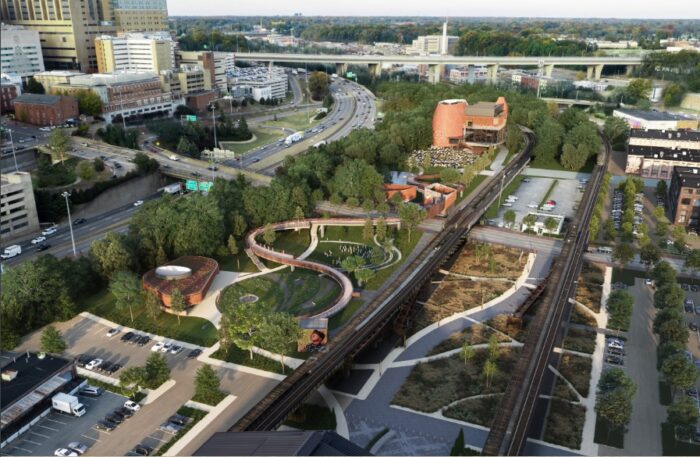
A rendering of the north-of-Broad portion of the site with the national slavery museum in the distance. (Images courtesy City of Richmond)
Richmond’s decades-long effort to commemorate its history as the nation’s second-largest slave market reached a milestone Tuesday with the unveiling of a new master plan for the 10-acre project in Shockoe Bottom.
City leaders and project stakeholders held an event at Main Street Station to present the plan for what’s now called The Shockoe Project, a relaunching of sorts of what was previously referred to as the Enslaved African Heritage Campus, and later, the Shockoe Bottom Heritage Campus.
Designed by a team led by architecture firm Baskervill, the plan shows the locations and conceptual images of the campus’s planned components, including a long-planned national slavery museum, burial ground memorials and other commemorative sites telling the area’s history as a slave-trade hub.
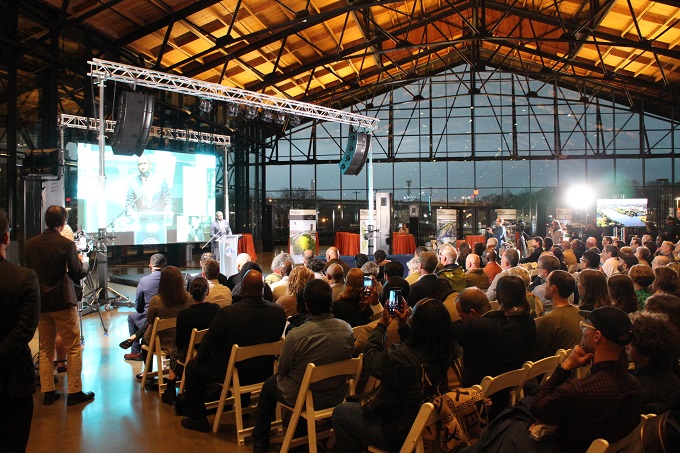
Tuesday’s event was held in the Main Street Station train shed, above the space that’s planned for the interpretive center. (Jonathan Spiers photo)
The plan marks a milestone in the decades-long effort, which dates back to the 1980s with the Richmond Slave Trail Commission and more recently has centered on the 10-acre campus with efforts by the Sacred Ground Historical Reclamation Project and other stakeholders.
Baskervill’s plan calls for the 62,000-square-foot museum to be located at the north end of the Shockoe Bottom African Burial Ground, a grassy area north of Broad Street between Interstate 95 and the train tracks. The grounds site also would include a memorial, a walking path and a 2,200-square-foot retail and restaurant pavilion fronting Broad Street.
The museum had been previously envisioned south of Broad Street, but a recently completed hydrology and hydraulic study of the area and the release of the latest Flood Insurance Rate Maps from the Federal Emergency Management Agency put that area in a delineated floodway, described as the most turbulent part of a floodplain where development is heavily restricted.
Instead, the area south of Broad Street between the interstate and the train tracks would house a garden, an event lawn and a 21,000-square-foot building commemorating the Lumpkin’s Slave Jail/Devil’s Half Acre site. A pedestrian bridge would connect the sites across Broad Street.
A starting point for the campus would be an interpretive center planned at Main Street Station. To be called Shockoe Institute, the center would fill the northern-end ground floor of the station’s train shed.
The center was awarded an $11 million grant from the Andrew W. Mellon Foundation for development and initial operations in 2022. Marland Buckner of Richmond-based MB2 Solutions is lined up to lead the center as executive director.
The Shockoe Project also is planned to include improvements and additional commemoration to other sites in and around Shockoe Bottom, including the Richmond Slave Trail and the Winfree Cottage, an enslaved woman’s home that is planned to be relocated from Shockoe Bottom back to its original location in Manchester.
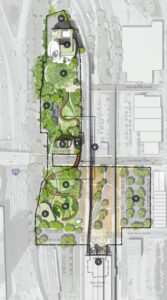
A site plan shows the 10-acre campus site on both sides of Broad Street between the interstate and the train tracks.
Also involved is the Shockoe Hill African Burying Ground site at 1305 N. Fifth St.; former slave trading sites throughout Shockoe Valley; and the Reconciliation Statue Plaza at Main and 15th streets, which is planned to be restored. The city purchased the 1.2-acre portion of the Shockoe Hill site at Fifth and Hospital streets in 2021 and has been planning archaeological research and commemoration.
The Shockoe Project effort is in the planning stages and is to involve community meetings, according to the city. A website for the project is slated to launch later this winter.
Funding allocated for the project thus far totals $38 million, with $25 million allocated by the city, and $13 million allocated by the Virginia General Assembly, which put $9 million of that amount toward development of the Lumpkin’s Jail site, $1 million toward planning for that site, and another $1 million toward Slave Trail improvements.
Adding to those amounts is the $11 million Mellon Foundation grant for the interpretive center. Private fundraising dollars are expected to supplement the interpretive center and the slavery museum, the latter of which is being driven by the National Slavery Museum Foundation.
According to the city, design for the slave trail improvements has been completed, while the Winfree Cottage relocation and design and Reconciliation Statue Plaza restoration design are about halfway complete. Slave trail improvements are underway and scheduled to finish construction this fall, and the Winfree Cottage relocation and site development is also scheduled for the fall.
A mural at the Shockoe Hill African Burying Ground site is nearly complete and expected to evolve with more community engagement this fall, when designs for the Lumpkin’s Jail site and the Shockoe Bottom African Burial Ground are also scheduled to get underway.
The Shockoe Project announcement came a day after City Council formally added the Shockoe Small Area Plan to the citywide Richmond 300 plan. The 150-page area plan, in the works since 2020, provides a guide for development centered on the planned heritage campus and slavery museum.
Tuesday’s event included comments from Mayor Levar Stoney, Baskervill principal Burt Pinnock, City Councilwoman Cynthia Newbille, Ana Edwards of the Sacred Ground Historical Reclamation Project, and Del. Delores McQuinn, who noted the effort to get to this point.
“We might not ever be able to chronicle all that the enslaved Africans had to endure, but we have an obligation to mark the path that they had to journey,” McQuinn said.
A website for the project, TheShockoeProject.com, launched with the event and details the plan, which can be viewed and downloaded here.
In addition to Baskervill, which also designed the Memorial to the Enslaved at William & Mary, the Shockoe Project consulting team included civil engineer VHB, landscape designer Waterstreet Studio, structural engineer Blue Nest, interpretive designer Riggs Ward, preliminary geotechnical engineer Schnabel Engineering, cost estimator OCMI, and archaeologist James River Institute for Archaeology.

A rendering of the north-of-Broad portion of the site with the national slavery museum in the distance. (Images courtesy City of Richmond)
Richmond’s decades-long effort to commemorate its history as the nation’s second-largest slave market reached a milestone Tuesday with the unveiling of a new master plan for the 10-acre project in Shockoe Bottom.
City leaders and project stakeholders held an event at Main Street Station to present the plan for what’s now called The Shockoe Project, a relaunching of sorts of what was previously referred to as the Enslaved African Heritage Campus, and later, the Shockoe Bottom Heritage Campus.
Designed by a team led by architecture firm Baskervill, the plan shows the locations and conceptual images of the campus’s planned components, including a long-planned national slavery museum, burial ground memorials and other commemorative sites telling the area’s history as a slave-trade hub.

Tuesday’s event was held in the Main Street Station train shed, above the space that’s planned for the interpretive center. (Jonathan Spiers photo)
The plan marks a milestone in the decades-long effort, which dates back to the 1980s with the Richmond Slave Trail Commission and more recently has centered on the 10-acre campus with efforts by the Sacred Ground Historical Reclamation Project and other stakeholders.
Baskervill’s plan calls for the 62,000-square-foot museum to be located at the north end of the Shockoe Bottom African Burial Ground, a grassy area north of Broad Street between Interstate 95 and the train tracks. The grounds site also would include a memorial, a walking path and a 2,200-square-foot retail and restaurant pavilion fronting Broad Street.
The museum had been previously envisioned south of Broad Street, but a recently completed hydrology and hydraulic study of the area and the release of the latest Flood Insurance Rate Maps from the Federal Emergency Management Agency put that area in a delineated floodway, described as the most turbulent part of a floodplain where development is heavily restricted.
Instead, the area south of Broad Street between the interstate and the train tracks would house a garden, an event lawn and a 21,000-square-foot building commemorating the Lumpkin’s Slave Jail/Devil’s Half Acre site. A pedestrian bridge would connect the sites across Broad Street.
A starting point for the campus would be an interpretive center planned at Main Street Station. To be called Shockoe Institute, the center would fill the northern-end ground floor of the station’s train shed.
The center was awarded an $11 million grant from the Andrew W. Mellon Foundation for development and initial operations in 2022. Marland Buckner of Richmond-based MB2 Solutions is lined up to lead the center as executive director.
The Shockoe Project also is planned to include improvements and additional commemoration to other sites in and around Shockoe Bottom, including the Richmond Slave Trail and the Winfree Cottage, an enslaved woman’s home that is planned to be relocated from Shockoe Bottom back to its original location in Manchester.

A site plan shows the 10-acre campus site on both sides of Broad Street between the interstate and the train tracks.
Also involved is the Shockoe Hill African Burying Ground site at 1305 N. Fifth St.; former slave trading sites throughout Shockoe Valley; and the Reconciliation Statue Plaza at Main and 15th streets, which is planned to be restored. The city purchased the 1.2-acre portion of the Shockoe Hill site at Fifth and Hospital streets in 2021 and has been planning archaeological research and commemoration.
The Shockoe Project effort is in the planning stages and is to involve community meetings, according to the city. A website for the project is slated to launch later this winter.
Funding allocated for the project thus far totals $38 million, with $25 million allocated by the city, and $13 million allocated by the Virginia General Assembly, which put $9 million of that amount toward development of the Lumpkin’s Jail site, $1 million toward planning for that site, and another $1 million toward Slave Trail improvements.
Adding to those amounts is the $11 million Mellon Foundation grant for the interpretive center. Private fundraising dollars are expected to supplement the interpretive center and the slavery museum, the latter of which is being driven by the National Slavery Museum Foundation.
According to the city, design for the slave trail improvements has been completed, while the Winfree Cottage relocation and design and Reconciliation Statue Plaza restoration design are about halfway complete. Slave trail improvements are underway and scheduled to finish construction this fall, and the Winfree Cottage relocation and site development is also scheduled for the fall.
A mural at the Shockoe Hill African Burying Ground site is nearly complete and expected to evolve with more community engagement this fall, when designs for the Lumpkin’s Jail site and the Shockoe Bottom African Burial Ground are also scheduled to get underway.
The Shockoe Project announcement came a day after City Council formally added the Shockoe Small Area Plan to the citywide Richmond 300 plan. The 150-page area plan, in the works since 2020, provides a guide for development centered on the planned heritage campus and slavery museum.
Tuesday’s event included comments from Mayor Levar Stoney, Baskervill principal Burt Pinnock, City Councilwoman Cynthia Newbille, Ana Edwards of the Sacred Ground Historical Reclamation Project, and Del. Delores McQuinn, who noted the effort to get to this point.
“We might not ever be able to chronicle all that the enslaved Africans had to endure, but we have an obligation to mark the path that they had to journey,” McQuinn said.
A website for the project, TheShockoeProject.com, launched with the event and details the plan, which can be viewed and downloaded here.
In addition to Baskervill, which also designed the Memorial to the Enslaved at William & Mary, the Shockoe Project consulting team included civil engineer VHB, landscape designer Waterstreet Studio, structural engineer Blue Nest, interpretive designer Riggs Ward, preliminary geotechnical engineer Schnabel Engineering, cost estimator OCMI, and archaeologist James River Institute for Archaeology.


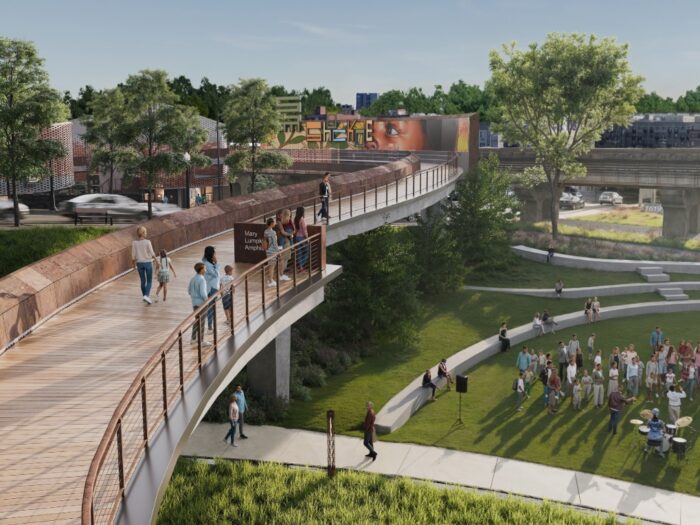
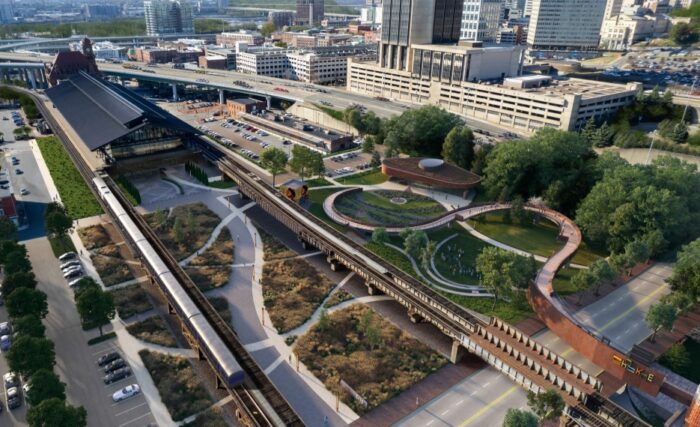


Richmond needs a Museum showcasing artist renderings of projects that never come to fruition.
Comment of the Year.
wish I had thought of that remark. top-down government can’t get enough of vanity projects.
What about the ones that come to fruition and end up in ruins from neglect?
Glad to see this finally underway! Much needed critical element to Richmond’s story. Unfortunate about the flood issues forcing a shift in the program, the connection with the bottom and farmers market would have given a stronger destination draw. The long dead ball park just east, outside of the historic area, would have solved the flooding issues, created a singular focused destination area with a full days worth of activities in one spot. Hopefully this project does not follow the timeline of the ballpark.
The ballpark idea was terrible. The parking needs alone killed it. This is much better as a stand alone.
Yeah, I am not even qualified to judge these things but even I was baffled when they proposed putting the ballpark there. The ONLY thing that made sense about it was proximate to the highway.
When you mention the farmers’ market, do you mean that concrete and paver frying pan in 17th street that looks like a parking lot with a few vendor sheds?
Under way!! HA HA HA. This the outgoing ad campaign for an unpopular Mayor that will NEVER fully come to life. This is the 4th or 5th the plan under three Mayors (Wilder, Jones – one with and without ballpark, and now Stoney) and two Govs (McDonnell and Terry). The funds so far are way to low for the total costs but at the same time CIty has no more funding to add, state budget is entering FY25 and FY26 budget and no new set asides are in it for this project. Not sure of the $12M from Bob and… Read more »
The worst thing is that Stoney, in typical politician fashion, is trying to take credit for all the people and $$ fleeing other “Blue State” areas for more sustainable financial circumstances that he would destroy if he had enough power.
Witness how many people are skipping over Richmond for NC cities as instructive. Richmond would be far better off if that Venture Richmond guy had been elected instead of him.
Why would you need a bridge over Broad Street to connect the two properties instead of using the existing large tunnel under Broad that already connects? Why would you even need an expensive elevated walkway at all?
They tried one over Broad St at 6th St, maybe this one will work out a bit better. Not holding my breath…….
That was for dying department stores. Not for an effort like this. Two totally separate efforts which should not be measured against one another.
Once again Richmonders can’t get over 6th St Marketplace. How many decades has it been? What a shock.
I’m not aware of the existence of the pedestrian tunnel but if there are flooding concerns, isn’t the tunnel affected? That sounds dangerous.
If there is flooding you won’t be walking down there at all so a tunnel versus an elevated walkway doesn’t really matter.
Remember Gaston!
You’re exactly right. Remember that no one died in the existing tunnel under Broad street during that. The people most in danger were the stupid ones in the cars that tried to drive through the flood waters and not the people that simply walked away.
Oh good, more master plans, project names, bldg renderings, bridge designs for us to look at.What is that now a sewing thimble?
All this town needs is another museum and training camp. Do we have a committee that convenes to figure out how to leave the citizens holding the debts for “exciting new projects”? How about attracting teachers and repairing the derelict buildings we call schools.
Yes. Good mayorship is judged by whether they get the “Small stuff” right — like improving school performance, keeping the city clean, etc….
This Mayor led the cause in replacing three significant school buildings. Let’s give him credit where it’s due.
Bruce this is the only city I know that I think DELIBERATELY lets perfectly good school structures fall into ruin in order to eventually shame outside folks into funding the bldg of entirely new structures. The elementary school I went to was built in the 1920s and it is better now than the day it opened, and that was also not a wealthy school district. They direct maintance to their Maoist jobs for administrators and who knows what else, and as the state of the facilities gets noticably bad they they do what democrats do — blame the failure on… Read more »
Like every other project this Mayor dreams up. It is for the kids. Not like all that money could be spent for something useful like the schools that are falling down or to help the kids that can’t pass grade level math or reading. This is a much better use of the money.
Yeah, if Stoney cared about Richmond’s kids (and he isn’t even from Richmond so that is dubious.) He would be demanding that the communists they hire do everything they can to make RPS a place that makes students ready for jobs or higher education, instead of making them more dangerous and difficult to teach in by doing such “Progressive” things like banning suspensions and expulsions for serious incidents and unmanageable classrooms. More people might actually want to put their kids in RPS and live the liberal dream of diversity and integration that I was raised on if they could make… Read more »
I’d be curious to know the inspiration behind the museum design. Looks like a modern-abstract take on Main Street Station.
Classic African tribal dwelling design.
Is this an accurate fact?
https://en.wikipedia.org/wiki/Musgum_mud_hut
It reminds me of the African-American Museum of History on the National Mall, which was also built in a flood zone.
Besides the fact that a museum commemorating this segment of our history should have been done a long time ago (if Wilder had not screwed it up multiple times), this area could have been programmed for park space such as a memorial garden before now. I commend the continued efforts of people working on this.
I hardly see how “Wilder messed it up” — Wilder was the guy who was keeping this alive, no matter the wisdom of doing that or not.
I was more talking about the failed museum in Fredericksburg before that. He originally sunk the site in Richmond by drawing attention to that and then screwed that one up too.
Just put Stoney’s museum in the train station and save millions.
This is not Stoney’s museum. This is a long time effort that predates him. It is a national museum addressing a portion of our collective history affecting millions.
The National one is in DC, this will be anything but…….
The national what? Slavery museum? Nope. I believe what you are thinking of is the National Museum of African American History and Culture. Slavery is only part of that.
You’re right, sorry,Stoney hates Lamar now.
There is no slavery museum in or near DC
This kind of looks to fluffy and ultra modern they need to build a replica of the original building and jails and rooms to show what Richmond’s Piece of Hell on Earth looked like in the 1840’s. In that in the history books and records it was a nightmare to see in real life.
This might serve an axe-to-grind with present day living people objective, but I hardly think this is something that will improve a city that wants to move on from the conflicts of the past.
Nobody is going to go into this mugging corridor. It won’t be used. It will be filled with homeless and trash in no time. Show of hands: Lone women runners, will you go?
“Anyone want to see if we can make it through the pretzel path with our wallets? Richmond City Jail just released some no-cash bonds, so we’ll have an extra challenge!”
Nah. Any site can be cleaned up — I honestly don’t know what the draw will be but this stretch is already cleaning up gradually thanks to private development.
I remember when I instinctively recognized the Bottom was one of the more dangerous places to be in Richmond (esp if you were drunk and unwise) — it definitely feels safer these days.
This is supposed to be a sacred space, not a place to go for a jog. I don’t remember seeing a recreational area when I visited Auschwitz a number of years ago. Recognizing and memorializing the horror that happened at this site is one of the most important things that we could be doing. Turning away from glorifying traitors in the public square was a start. Now the more difficult task begins. If you don’t understand that, then I have nothing left to say.
As a Northerner, I think I can say from my reading of the History that it is really dubious to say that these people were “Traitors”, no matter what else they were. One has to understand that the USA was forever changed in some ways DURING the Civil War — introduction of the Greenback, income tax, etc. That whatever else Lincoln did, for whatever reason, he actually violated the Constitution in several ways and there was no provision against secession, which is why they never tried Jefferson Davis but held him unconstitutionally in a damp jail until he was so… Read more »
Mike Dickenson?
Oh my goodness, Ed. You may be on to something here…
The design is stunning. Burt Pinnock has outdone himself!
The garden plan is exquisite. However, after spending a lot of time in the area I’m not sure if it will be able to capture the sense of peacefulness there. Between the highway and the active train station, the area is very loud.
Also, I too question the need for the bridge over Broad (although, it looks like it would be a cool high line-esq experience). There is an underpass that would serve the area well.
Will the historic structures referenced be present/recreated or ignored in favor of the museum experience???
The design looks ugly and boring but what’s new.
As a African American from Richmond city that made it out . Respectfully this looks really bad and I’m not the only one saying it.
At least it looks interesting. I say this as a European American not even from the region. I get why you feel it is relevant to post your cred, but it is a sad state of affairs that we tend to judge the statements so much by the immutable characteristics of the people.
I guess the question, and I am not saying I know the answer, is what SHOULD such a museum look like ideally?
I know there is a very near future replacement of the Broad St overpass at I-95, within the next month. This is very close to the project in the article. The “tunnel” discussed is, an old underpass at Broad St, just east of the interstate. Much of the surrounding property is former Southern Coast Line Railroad (embossed in concrete on the platform office building, just west of Main Street Station). Looks like that private office space will be spared. I couldn’t help but notice the great loss to the VCU Lot A, most of which is former track siding, for… Read more »
Slavery is, unfortunately, an important part of American history. I am glad to see the museum. I hope it is historically accurate and balanced, grinding no axes. I was puzzled about one thing. I went to the Holocaust Museum in Washington and when I got to the bottom saw that there was a restaurant. You will understand why I was not hungry. I wonder how people are going to be hungry if they get a 3D accurate view of what slavery was like for folks on the receiving end.
Norman Finkelstein has a name for Holocaust Inc.
A lazy reliance on the antiquity of an institution(slavery) is ,by far, less honorable than an honest industry.